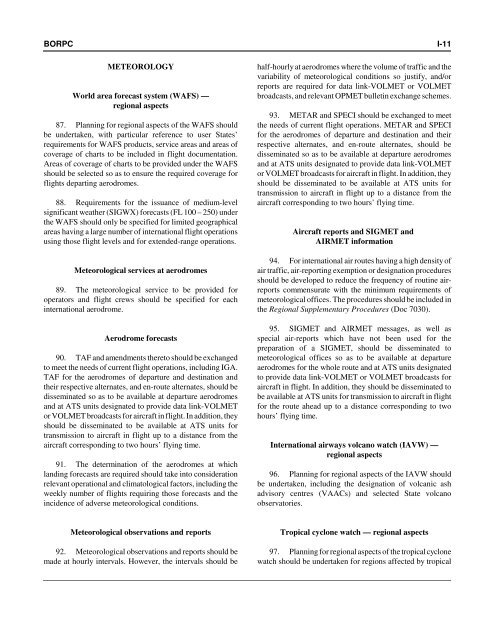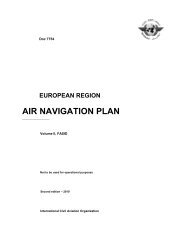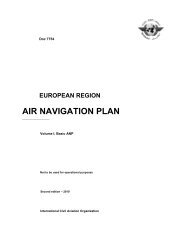Asia and Pacific Regions AIR NAVIGATION PLAN - ICAO Public Maps
Asia and Pacific Regions AIR NAVIGATION PLAN - ICAO Public Maps
Asia and Pacific Regions AIR NAVIGATION PLAN - ICAO Public Maps
Create successful ePaper yourself
Turn your PDF publications into a flip-book with our unique Google optimized e-Paper software.
BORPC I-11<br />
METEOROLOGY<br />
World area forecast system (WAFS) —<br />
regional aspects<br />
87. Planning for regional aspects of the WAFS should<br />
be undertaken, with particular reference to user States’<br />
requirements for WAFS products, service areas <strong>and</strong> areas of<br />
coverage of charts to be included in flight documentation.<br />
Areas of coverage of charts to be provided under the WAFS<br />
should be selected so as to ensure the required coverage for<br />
flights departing aerodromes.<br />
88. Requirements for the issuance of medium-level<br />
significant weather (SIGWX) forecasts (FL 100 – 250) under<br />
the WAFS should only be specified for limited geographical<br />
areas having a large number of international flight operations<br />
using those flight levels <strong>and</strong> for extended-range operations.<br />
Meteorological services at aerodromes<br />
89. The meteorological service to be provided for<br />
operators <strong>and</strong> flight crews should be specified for each<br />
international aerodrome.<br />
Aerodrome forecasts<br />
90. TAF <strong>and</strong> amendments thereto should be exchanged<br />
to meet the needs of current flight operations, including IGA.<br />
TAF for the aerodromes of departure <strong>and</strong> destination <strong>and</strong><br />
their respective alternates, <strong>and</strong> en-route alternates, should be<br />
disseminated so as to be available at departure aerodromes<br />
<strong>and</strong> at ATS units designated to provide data link-VOLMET<br />
or VOLMET broadcasts for aircraft in flight. In addition, they<br />
should be disseminated to be available at ATS units for<br />
transmission to aircraft in flight up to a distance from the<br />
aircraft corresponding to two hours’ flying time.<br />
91. The determination of the aerodromes at which<br />
l<strong>and</strong>ing forecasts are required should take into consideration<br />
relevant operational <strong>and</strong> climatological factors, including the<br />
weekly number of flights requiring those forecasts <strong>and</strong> the<br />
incidence of adverse meteorological conditions.<br />
half-hourly at aerodromes where the volume of traffic <strong>and</strong> the<br />
variability of meteorological conditions so justify, <strong>and</strong>/or<br />
reports are required for data link-VOLMET or VOLMET<br />
broadcasts, <strong>and</strong> relevant OPMET bulletin exchange schemes.<br />
93. METAR <strong>and</strong> SPECI should be exchanged to meet<br />
the needs of current flight operations. METAR <strong>and</strong> SPECI<br />
for the aerodromes of departure <strong>and</strong> destination <strong>and</strong> their<br />
respective alternates, <strong>and</strong> en-route alternates, should be<br />
disseminated so as to be available at departure aerodromes<br />
<strong>and</strong> at ATS units designated to provide data link-VOLMET<br />
or VOLMET broadcasts for aircraft in flight. In addition, they<br />
should be disseminated to be available at ATS units for<br />
transmission to aircraft in flight up to a distance from the<br />
aircraft corresponding to two hours’ flying time.<br />
Aircraft reports <strong>and</strong> SIGMET <strong>and</strong><br />
<strong>AIR</strong>MET information<br />
94. For international air routes having a high density of<br />
air traffic, air-reporting exemption or designation procedures<br />
should be developed to reduce the frequency of routine airreports<br />
commensurate with the minimum requirements of<br />
meteorological offices. The procedures should be included in<br />
the Regional Supplementary Procedures (Doc 7030).<br />
95. SIGMET <strong>and</strong> <strong>AIR</strong>MET messages, as well as<br />
special air-reports which have not been used for the<br />
preparation of a SIGMET, should be disseminated to<br />
meteorological offices so as to be available at departure<br />
aerodromes for the whole route <strong>and</strong> at ATS units designated<br />
to provide data link-VOLMET or VOLMET broadcasts for<br />
aircraft in flight. In addition, they should be disseminated to<br />
be available at ATS units for transmission to aircraft in flight<br />
for the route ahead up to a distance corresponding to two<br />
hours’ flying time.<br />
International airways volcano watch (IAVW) —<br />
regional aspects<br />
96. Planning for regional aspects of the IAVW should<br />
be undertaken, including the designation of volcanic ash<br />
advisory centres (VAACs) <strong>and</strong> selected State volcano<br />
observatories.<br />
Meteorological observations <strong>and</strong> reports<br />
92. Meteorological observations <strong>and</strong> reports should be<br />
made at hourly intervals. However, the intervals should be<br />
Tropical cyclone watch — regional aspects<br />
97. Planning for regional aspects of the tropical cyclone<br />
watch should be undertaken for regions affected by tropical














